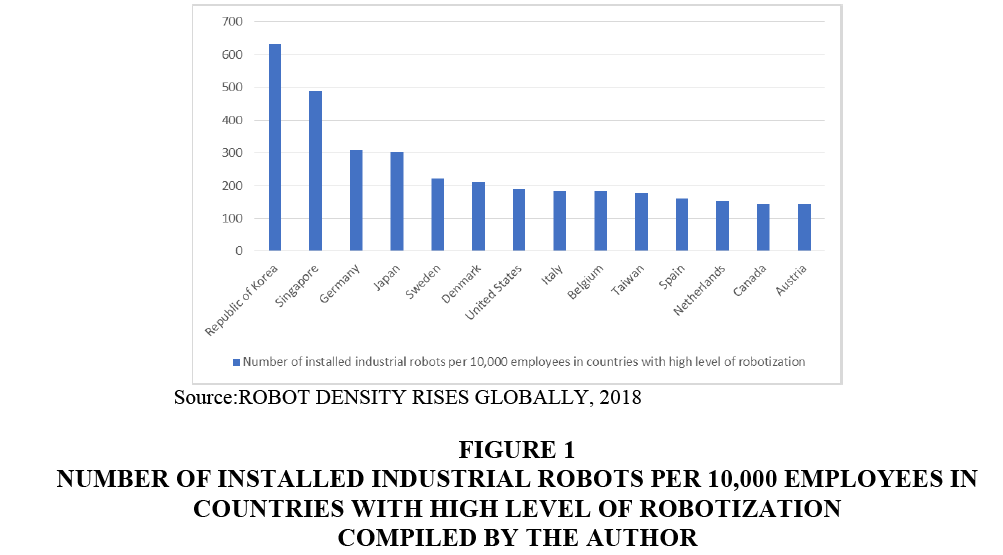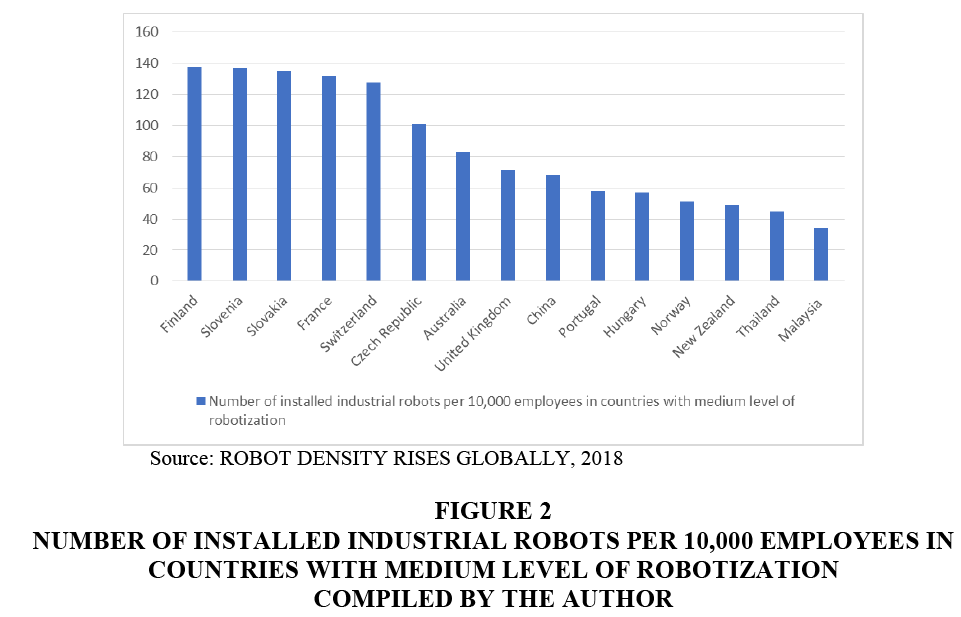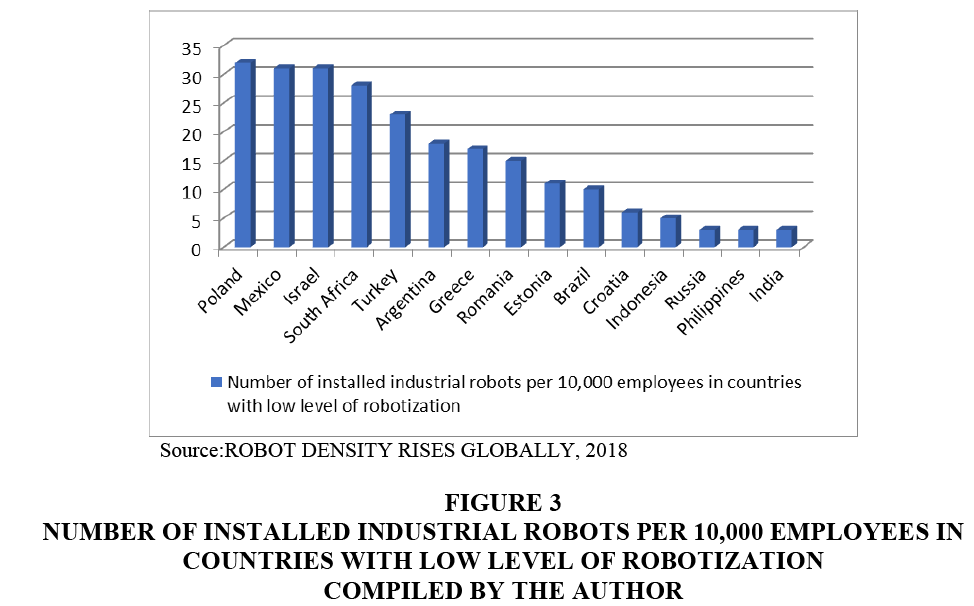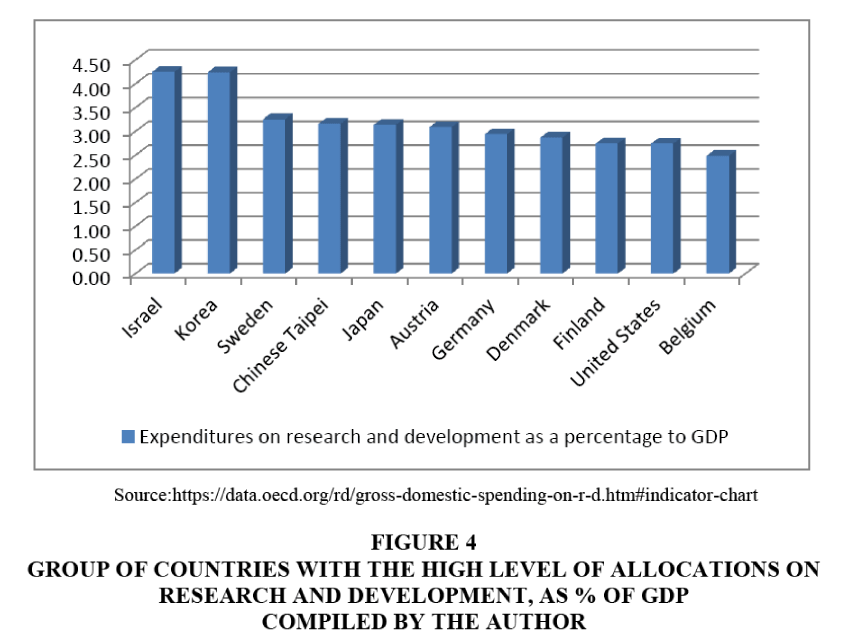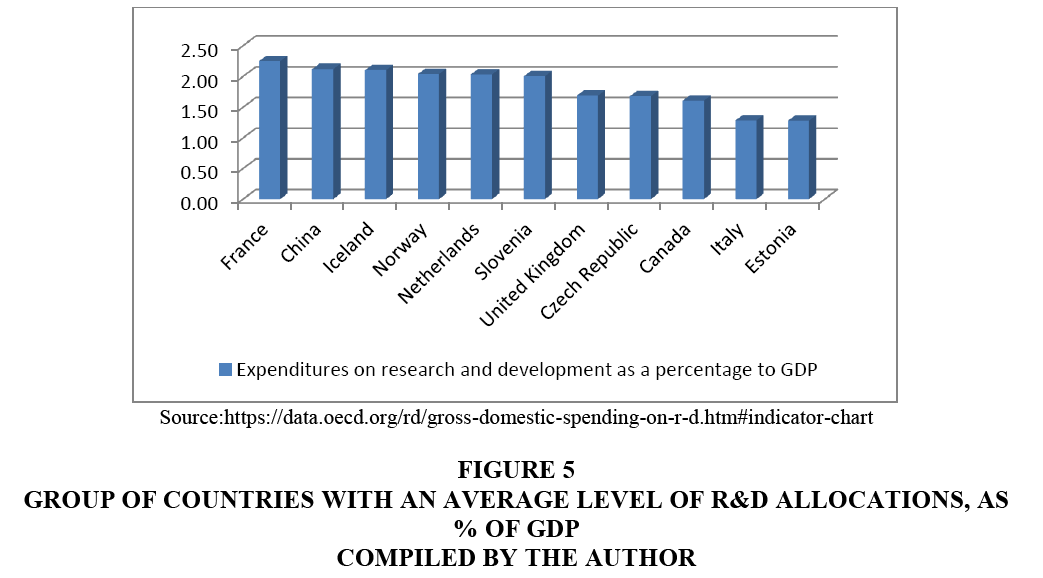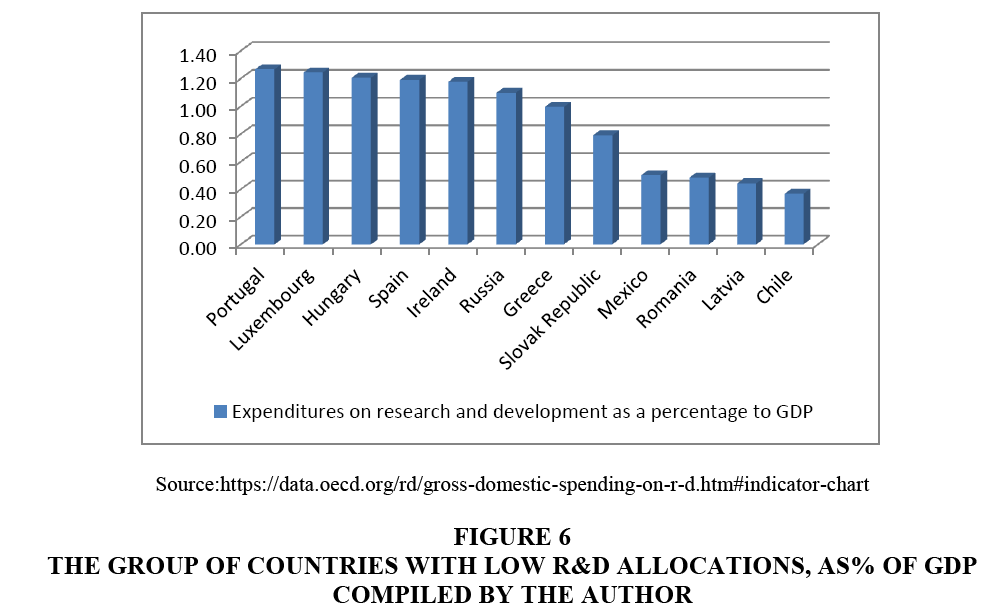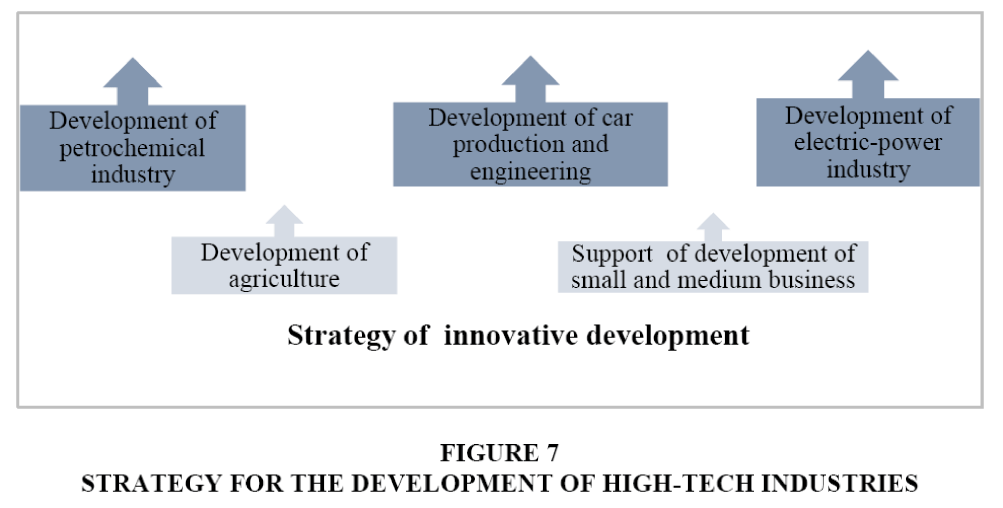Research Article: 2018 Vol: 21 Issue: 3
Comparative Perspectives on Innovative Development of Russian Economy: Influence of Sustainable Factors?
Ramil R. Khairutdinov, Kazan Federal University
Tatjana G. Antropova, Kazan national research technical university of A.N. Tupolev-KAI (KNITU-KAI)
Oleg N. Golland, Kazan national research technical university of A.N. Tupolev-KAI (KNITU-KAI)
Flera G. Mukhametzyanova, Kazan Federal University
Alfiya Sh. Yarullina, Kazan Federal University
Luiza K. Karimova, Kazan Federal University
Abstract
Innovations are an endogenous factor of economic growth, the potential of which is realized under the condition of formation of measures of the state influence for the solution of a problem of integration of economy into the world scientific landscape. Innovative capabilities of the country can be strengthened, using the potential of venture capital, which plays a systemic role in the economy due to the continuous and timely supply of innovations with required investment. Innovative capabilities can be enhanced using the potential of the cluster structure of the interaction of small and large businesses, as well as stimulating innovative production in accordance with scientifically elaborated state strategy. The purpose of the research is to analyze the factors influencing the level of innovative development of the country. The article explores the peculiarities of the current stage of development of the innovative economy of developed and developing countries, the authors studied these aspects at the level of the Russian Federation and the Republic of Tatarstan. The authors formulate the recommendations for achievement of a high-quality economic growth based on an innovative type of economic development.
Keywords
Innovation, Research and Development, Gross Domestic Product, Innovative Type of Economic Development, Investment Progress, Economic Growth, Technological Modernization.
Introduction
Innovations and novel technology are the key factors of sustainable economic growth in today's global economy. Schumpeter Joseph is one of the first economists who launched and researched innovation concept. He insisted that innovation is a source of economic change (Bayarcelik & Ta?el, 2012).
The relationship between innovation and economic growth has been well studied. Research and development (R&D) includes creative work undertaken on a systematic basis in order to increase the stock of knowledge, including knowledge of man, culture and society, and the use of this stock of knowledge to devise new applications (Torun & Cicekci, 2007).
The Europe 2020 strategy (Dr?cea et al., 2014) aims to intend European society into a single focus on knowledge. This EU orientation will have an important impact on research and development in all Member States and encourage them to increase their support and interest in this sector through public policies, adequate tools, and adequate investments, placing them among its priorities.
The scientific literature proves that investment in R&D and R&D personnel working in the field are the main indicators for the level of innovation (Venckuviene et al., 2014). But researchers differ in their statements about what factors can ensure stable innovative development.
R&D expenditure as percentage of GDP is the most widely used indicator for evaluating and comparing innovative development in different countries (Bayarcelik & Ta?el, 2012; Cavdar & Aydin, 2015). As well as human resources indicators e.g. number of science and technology graduates and the number of researchers employed in R&D. It is one of the most important resources for the economic growth and social development.
The paper (Anvari & Norouzi, 2016) investigated the impact of e-commerce and R&D on economic development in 21 selected countries. The results showed that e-commerce and R&D had a positive and significant impact on GDP per capita based on purchasing power parity, with e-commerce having a stronger development-enhancing effect in comparison to R&D.
Importance of innovation for economic development of a country is already unquestionable. However, for successful innovation development of the economy in every country, it is necessary to establish certain assumptions that should be ensured by the state (Fabová & Janáková, 2015). Authors emphasize such factors as human resources, appropriate research system, financial availability for innovation projects and the promotion of innovation by the government. The mentioned assumptions will allow the companies to take advantage and turn the desired results only if the state helps with the tools of economic policy to create a suitable pro-innovative business environment which will lead to increasing the effectiveness of innovation.
Researchers (Gackstatter et al., 2014) argues that the push toward an innovation-based economy is actually not dependent on total expenditure on R&D, but rather relies on the efficient allocation of investments and the rigorous implementation of innovation strategy. Countries need to find their own way for national development, adapting their own policy measures to national conditions. Countries need to define their own aspirations and goals including thorough analysis of their current situation and ways to close gaps which can but do not have to lead to an increased R&D spending.
One can note economic growth requires innovation that can only arise as a result of the entrepreneurial activity (Leyden, 2016). Efforts to stimulate these actions through the center directions and explicit planning are limited by the inability to forecast future actions and consequences. A more reasonable approach is to create a more supportive environment in which entrepreneurial activities can occur in both the private and the public sectors.
The most popular indicator for measuring innovation in scientific literature is an investment in R&D. It should be admitted that trust in investing in R&D is too difficult, given the multifaceted nature of innovation. Findings of (Venckuviene et al., 2014) show the technological potential is the core factor for competitiveness in the low-tech sector. However, in (Tuna et al., 2015) it is concluded that there is no relationship between R&D expenditures and economic growth as a result of the empirical tests applied. This circumstance can be elucidated by the fact that Turkey is a developing country, and the investment volumes allocated to R&D expenditures show considerable increases in recent decades. Thus, the R&D activities need long-term technical efforts, and the benefits of those expenditures can be seen in the economy in a period of next 20 or 35 years.
Thus, it can be argued that there is a set of researches that attempt to determine the relationship between R&D investment and the country's economic growth, emphasizing the various factors of this impact. Some authors state that the impact of R&D on efficiency is almost equal to zero, while others note that the impact of research and development is significant and far exceeds the impact of other types of investment. In addition, the results depend on the level of development of the country. It is proved that for developed countries the relationship between the amount of investments in R&D and the level of economic growth is more noticeable, but for the developing countries this relationship has not yet been established unambiguously.
It is necessary to understand what factors can affect the country's innovative development and economic growth and whether the increase in the share of allocations for R&D is the key to the successful development of innovations.
Innovative development of Russia has been declared a priority area of the national policy, but the current state of the domestic machine-building complex does not correspond to the declared rate, which poses a real threat to the stability of national enterprises. The purpose of this work consists in scientific research of contents and tools for the formation of factors of a favorable external environment for the maximum possible activity of the state, regional and sectoral policy in the field of stimulation of innovative activity and acceleration of innovative progress in the modern Russian economy.
Research Methods
To identify the factors of sustainable innovation development of countries, several types of indicators were used:
1. Indicator reflecting the level of the country's economic development (GDP).
2. Number of installed industrial robots per 10,000 employees in the manufacturing industry in 2016. The figures are received from the International Federation of Robotics (IRF) Press Releases for 2017.
3. Indicators showing the level of expenditure on R&D for 13 countries, with details by source of funding. The data source is OECD Data (https://data.oecd.org/).
To interpret the results of research and identify the factors of innovative development of the country, the surveyed set of states was divided into subgroups, depending on the level of the values of the selected indicators. The interrelation between the level of spending on R&D and the level of robotization of production of countries is found.
Results
In the Russian Federation there is a unique situation from the point of view of the theory and practice economy. The imposed external restrictions significantly affected the existing economic structure of the country, which had a multiplier effect on all spheres of public life. The income of citizens has especially suffered. Starting from the second half of 2014, a significant reduction of income has influenced considerable reduction in expenses of citizens, which ultimately affected GDP.
Considering that consumer expenses served as the main driver of growth of economy, the government needs to change conceptual model of economic growth now. At the same time, the imposed sanctions and anti-sanctions provide an opportunity for further development of own production with all the ensuing consequences: increase in employment, increase in labor productivity, development of innovative areas of activity, but the lag from positive effect of effective industrial policy varies in each sphere, on average, from 3 to 5 years. In this case the paradoxical situation is the reduction of the GDP of the country, on the one hand, and the potential for a medium-term outlook for sustainable development through increased competitiveness, based on effective implementation of the import substitution program and increase in level of localization of production, on the other.
For the last 8 years (2008-2016) GDP of Russia has increased only by 4.3% and according to this indicator our country is very far off the list of not the most leading world countries. Whereas in the second half of Leonid Brezhnev’s reign, which also lasted 8 years (1974-1982) and entered the country's history as an era of stagnation, GDP of the USSR increased by 13.5% (Dand & Hamzan, 2015)
Today the economy has entered a state which is relatively called "near zero". We have a small growth in the economy, but its size is comparable to a statistical error and according to analysts at the end of the year it won't exceed 2%.
Limiting factors in achieving reference points to increase economic indicators, stated in long-term programs of development (Bayarcelik & Ta?el, 2012) are still the established structure of the economy with orientation to raw assets and the external energy market. The basis of qualitative growth should be made up of innovative enterprises, which, in turn, will be developed through the effective implementation of the policy of import substitution and increasing the level of localization of production.
At the moment the transition of the Russian Federation from the raw industrial economy to an innovative economy is a key factor of strengthening its position in world markets in difficult economic conditions caused by the sanctions regime and reduction of oil prices. It is necessary to implement multi-disciplinary strategic initiatives based on the development of a mechanism for creating a favorable innovative climate. A model of innovative development should open optimum resource and information support of innovative activity. In general, we require a very complex and controversial reform, which should be resolved by the authorities (Tuna et al., 2015).
Changes in the economy of the XXI century are based on wide use of global telecommunication networks, Internet technologies, automation and robotization. The economic development of the country strongly depends on automation and robotization. According to the 2017 World Robot Statistics, issued by the International Federation of Robotics (IFR) (Robot density rises globally, 2018) the new average of global robot density in the manufacturing industries achieved 74 robot units per 10,000 employees. By regions, the average robot density in Europe is 99 units, in the Americas 84 and in Asia 63 units. The leader in industrial robotic automation is South Korea. Dividing countries into three groups according to number of installed industrial robots per 10,000 employees in the manufacturing industry in 2016 the following groups are received: countries with the high level of robotization, medium level of robotization and low level of robotization (Figures 1-3)
Figure 1: Number of installed industrial robots per 10,000 employees in countries with high level of robotization Compiled by the author
Figure 2: Number of installed industrial robots per 10,000 employees in countries with medium level of robotization Compiled by the author
Figure 3: Number of installed industrial robots per 10,000 employees in countries with low level of robotization Compiled by the author
Russia belongs to the group of countries with low level of robotization. The number of industrial robots per 10,000 of population is two orders of magnitude less than in leading countries. In order to change the level of innovation development it is reasonable to research the amount of expenditures on R&D.
Today the situation in the Russian Federation in many directions of scientific and technical progress, an innovative breakthrough remains very unfavourable. In Russia, on average, only 8-10% of innovative ideas and hi-tech products are used, whereas, for example, in the USA–62%, in Japan–95%. The domestic factory science performs only 6% of scientific research and in the companies of EU countries–65%, in Japan–71%, in the USA–75% (Cavdar & Aydin, 2015) (Table 1).
| Table 1 Indicators of Innovative Activity in the Regions of the Volga Federal District |
|||
| The name of the regions | The share of organizations engaged in innovative activity in the total number of the surveyed organizations, in % | The share of innovative products in the total volume of shipped products of innovative enterprises, in % | The proportion of significantly changed or newly introduced products in the total volume of innovative products, % |
| Russian Federation | 9.0 | 9.1 | 57.5 |
| Republic of Tatarstan | 12.5 | 12.0 | 68.0 |
| Republic of Bashkortostan | 6.4 | 6.8 | 69.2 |
| Samara region | 19.0 | 10.0 | 73.2 |
| Perm region | 29.9 | 10.9 | 63.8 |
| Republic of Mari-El | 2.9 | 19.8 | 13.4 |
| Kirov region | 3.0 | 6.9 | 66.3 |
| Nizhny Novgorod region | 13.7 | 6.8 | 52.0 |
| Penza region | 4.4 | 11.6 | 95.1 |
| Saratov region | 8.2 | 4.1 | 76.8 |
| Udmurt Republic | 7.8 | 2.4 | 51.3 |
| Ulyanovsk region | 6.0 | 7.3 | 33.1 |
| Chuvash Republic | 8.6 | 9.3 | 64.5 |
Influence of Sustainable Factors
It is proved that carrying out R&D has a positive effect on the overall efficiency of factors of production and at the same time contributes to economic growth and increases the country's competitiveness (Adamou & Sasidharan, 2007; Yang & Lin, 2007; Coad & Rao, 2008; Eveleens, 2010).
The main factors which are still constraining innovative activities in Russia (Anvari & Norouzi, 2016) are lack of financial resources and insufficient level of the state support. Over the past decades funds for financing fundamental and applied scientific research were directed in the range of 1% of GDP.
Dividing countries into three groups by indicator-Expenditure on R&D as a percentage of GDP, groups of countries-with high levels of allocation, with an average level and with a low level are obtained.
Figure 4 shows countries with a high level of investment in R&D as a percentage of GDP. Almost all representatives of this group have, respectively, a high level of robotization of production, such as the Republic of Korea, Japan, Sweden, Denmark, the USA, Belgium, and Austria. Israel, which leads the group of countries in terms of allocations for R&D, according to the level of robotization belongs to the group with a low level of robotization of production. This is explained by the intensive development of Israel at the present time.
Figure 4: Group of countries with the high level of allocations on research and development, as % of gdp Compiled by the author
France, Ireland, Norway, the Netherlands, Slovenia, the Czech Republic, and others belong to the group of countries with an average level of investment (Figure 5)
Figure 5: Group of countries with an average level of r&d allocations, as % of gdp Compiled by the author
According to this indicator, Russia, which has set the ambitious task–the creation of a competitive economy, based on intellect and knowledge -an economy in which the main engine is not the rate of exploitation of natural resources, namely the idea, inventions and ability quicker than others to implement them in everyday life-lags behind the developed countries of the world more than twice (Japan–3.14% of GDP, the USA–2.74% of GDP, Germany–2.94% of GDP, Great Britain–1.69% of GDP). And it is characteristic that half of the spending on science in developed countries is supported by the state. In terms of relative spending on science-in percentage of GDP, Russia is still lower, in 28th place, from 34 countries that were investigated (Figure 6).
Twenty of the leading countries in the volume of internal expenditures on research and development spend 20151 billion US dollars (calculated at the purchasing power of national currencies). In comparison with 1995, Russia hasn't much improved the positions in the rating of the leading countries of the world in terms of domestic costs for R&D, moving from 10th to 9th place. China has significantly strengthened its positions, having risen from 7th to 2nd place thanks to an annual growth of expenses on R&D (on average for 17.1%). Correspondingly, Japan was displaced from 2nd place on 3rd, and Germany—from 3rd on 4th. (Dr?cea et al., 2014)
Now the leadership of the country has given the Russian Academy of Sciences a mandate of trust in order to play an even greater role in the life of our country. Similarly, in countries where relations are not very good with us now, science is looked upon as a significant force, as a generator of new knowledge and as a productive force of the economies of these states, so scientists there have sufficient influence on decision-making. Today, we are also working on strengthening the positive innovative image of our country.
And industry, in fact, has not started financing the science. The problem is that high-tech economies usually invest in science, and our economy is mainly raw materials. Therefore, naturally, according to the laws of a market economy, investing in science to get a quick profit, it is not very necessary. We consider that it is necessary to establish a fund for the instrumentalization of Russian science. It should be about 30 billion rubles a year and we consider it politically correct that this fund should be formed at the expense of the profit tax of our raw material corporations and state-owned companies. After all, the riches and incomes that they now have, in general, are received by the labor of our scientists (Benešová & Smutka, 2016).
One of the important factors characterizing the level of investment in R&D is the source of funds. Investments from the state fund often do not require a guaranteed start-up in the production and sale of innovative products. Thus, investments, as a rule, give a result only at the level of fundamental research and are not commercialized. Investments from business in R&D always assume financial benefits, that is, an innovative product must be sold to the consumer.
Investments in R&D for countries with detailed information on sources of financing are given in Table 2.
| Table 2 Investments In R&D For Countries With Specification On Funding Sources, Millions Of Us Dollars |
||||||
| Total (funding sector) | Business enterprise | Sub-total government | Higher education | Private non-profit | Funds from abroad | |
| Russia | 40522.05 | 10728.07 | 28170.13 | 481.79 | 69.41 | 1072.65 |
| Czech Republic | 6932.98 | 2393.65 | 2233.43 | 49.09 | 3.65 | 2253.17 |
| Japan | 170081.82 | 132616.85 | 26181.98 | 9212.85 | 1255.06 | 815.10 |
| Iceland | 345.92 | 115.03 | 110.72 | 14.37 | 14.63 | 91.16 |
| Korea | 74217.71 | 55326.25 | 17562.27 | 477.87 | 293.38 | 557.94 |
| Austria | 13120.36 | 6172.98 | 4801.21 | 60.04 | 2086.14 | |
| Denmark | 8242.87 | 4893.96 | 2423.41 | 387.71 | 537.79 | |
| Finland | 6717.79 | 3678.97 | 1940.46 | 20.25 | 102.58 | 975.54 |
| Unated States | 502893.00 | 322 617 | 120874.00 | 17127.00 | 18 788 | 23 487 |
| China | 408828.98 | 305501.44 | 86936.61 | 3034.38 | ||
| United Kingdom | 46297.24 | 22404.30 | 12954.50 | 571.61 | 2223.51 | 8143.32 |
| Estonia | 569.71 | 233.60 | 264.15 | 1.19 | 1.34 | 69.42 |
| Slovenia | 1460.04 | 1010.48 | 290.35 | 4.95 | 0.11 | 154.15 |
Compiled by the author, Source:https://stats.oecd.org/Index.aspx?DataSetCode=GERD_FUNDS#
Table 3 shows the structure of funding sources for R&D by countries for 2015.
| Table 3 Structure Of R&D Funding Sources |
|||||
| Business enterprise | Sub-total government | Higher education | Private non-profit | Funds from abroad | |
| Russia | 0.26 | 0.7 | 0.01 | 0 | 0.03 |
| Czech Republic | 0.35 | 0.32 | 0.01 | 0 | 0.32 |
| Japan | 0.78 | 0.15 | 0.05 | 0.01 | 0 |
| Iceland | 0.33 | 0.32 | 0.04 | 0.04 | 0.26 |
| Korea | 0.75 | 0.24 | 0.01 | 0 | 0.01 |
| Austria | 0.47 | 0.37 | 0 | 0 | 0.16 |
| Denmark | 0.59 | 0.29 | 0 | 0.05 | 0.07 |
| Finland | 0.55 | 0.29 | 0 | 0.02 | 0.15 |
| Unated States | - | 0.24 | 0.03 | - | - |
| China | 0.75 | 0.21 | 0 | 0 | 0.01 |
| United Kingdom | 0.48 | 0.28 | 0.01 | 0.05 | 0.18 |
| Estonia | 0.41 | 0.46 | 0 | 0 | 0.12 |
| Slovenia | 0.69 | 0.2 | 0 | 0 | 0.11 |
Compiled by the author, Source:https://stats.oecd.org/Index.aspx?DataSetCode=GERD_FUNDS#
Business investments in countries with a high level of robotization exceed 50%, and in some (for example, Japan, Korea)-70%.
Our largest Corporations’ investing in science is extremely low: the share of their spending on science from revenue is 5-10 times lower than that of foreign competitors. The real structural reorganization of the national economy should become a tool in realization of a new socio-economic policy, and the growth of labor productivity, and its growth by at least 70-75% due to the innovative component, should become the most important direction of qualitative economic growth and social progress. The basis of transition to an innovative model of economy should be based primarily on domestic savings, which are present in the country, stimulating the ways of their inflow in the economy.
Thus, successful economic growth and increased competitiveness of the country require investments in R&D, the latest research in specific scientific and practical fields. It can be argued that an important factor for innovative development is not just an increase in the percentage of investments in R&D, but investment from business. This is what guarantees that an innovative product will reach the end-user market.
Huge resource investment for the new innovative economy lies in the equitable redistribution of income, the use of a progressive tax scale, as in all developed and developing countries, as well as the introduction of taxes on luxury and over-consumption, increase in the corporate profit tax rate, which must leave offshore zones and get registered in Russia.
The most important directions of development of innovative economy are strengthening of actions in such strategic directions as:
1. Consolidation of leadership in those directions where the Russian scientific and industrial complex has technological superiority (rocket-space, aviation, nuclear equipment, etc.) is important.
2. The strategy of the catching-up development in the directions with considerable lag (nanotechnologies, genetic engineering, biotechnology, robotics, informatics, materials with predefined properties).
3. Formation and wide use of the large scientific and educational centres, science cities, active use of federal scientific and technical target programs are required.
4. Regulation of pricing in natural monopolies, including raw, ensuring full transparency of the price structure should be performed.
5. Limiting the difference between the price of the manufacturer (or the importer) and retail, depending on the commodity group, not more than 25-50% is necessary to establish.
6. The improvement of the system of public finances and normalization of monetary circulation, i.e. transition from restrictive monetary policy to the policy stimulating to combat inflation through the economic growth, the advancing monetary supply of money from the Central Bank is important.
Stimulation of long-term crediting of the real sector by the rate for investment development of business no more than 2-4%, severely separating investment money from speculative ones is required.
Restoration of the unified energy system of Russia, the integrity of an artificially fragmented unified technological complex is proposed.
Of course, it is required to make essential changes of tax system in the direction of increase on goods that are inaccessible to the middle class; to impose a property tax of approximately 1% of market value and finally introduce a progressive scale of taxes, at the same time releasing those, who have an income below the subsistence minimum.
To get the country out of the systemic crisis, to achieve high-quality economic growth and to increase welfare of the people, considerable investments are needed, and investments should be direct into the real sector, rather than portfolio, speculative, to the stock and financial markets.
Unfortunately, in Russia only 25% of investments go to the real sector, and 75%-to speculative. The trend of capital outflow from Russia is not decreasing. Net outflow of capital from Russia in five months of 2017 increased more than twice-to $22.4 billion against $10.3 billion the previous year. Following the results of 2017, the Central Bank predicts outflow volume in $37 billion. Today, according to estimates, 3000-3200 billion dollars belonging to Russians are located abroad. The value is quite comparable with the annual budget of the Russian Federation.
Calculations show that Russia's economic development would have been three to four times higher, if there had not been a freeze on the third part of budget revenues in the form of the Reserve Fund and the National Welfare Fund, there was no withdrawal from the economic turnover for the purpose of supporting developed capitalist countries under very low interest, but invested in their own national economy in cooperation with the possibilities of corporate financing on the basis of tax incentives.
Having established strategic guidelines for economic growth and innovative policy of the country, the Government should take care of assessing its innovative image, having defined the system of indicators and carrying out monitoring of the innovative image of the Russian Federation.
The innovative activity in some regions of Russia, for example in the Republic of Tatarstan is characterized by positive growth. This is reflected in the dynamics of new technologies, developed and being introduced into production, allowing to increase productivity and science-intensity of products and services, and, in general, at the rates of technical and technological modernization of the economy of the region. The system of training of scientific research workers and postgraduate education is also effective in Tatarstan. The effectiveness of the use of new technologies in the volume of innovative products remains high. Innovation index of the region's production was 18.6% in 2014. According to this indicator the Republic of Tatarstan ranks 4th among the subjects of the Federation (Ionescu, 2015). RT is consistently and actively developing high-tech industries and innovative sectors of the economy. Also the degree of intellectual labor is high here (Figure 7).
To activate the innovative potential of the Republic of Tatarstan, the regional authorities determined large-scale investment projects that would have a stimulating effect on the economy of the region as a whole. Their list for 2017 covers all the leading branches of economy of RT (Fabová & Janáková, 2015) and thus raised the Republic to the top 3 regions with high innovative activity and investment attractiveness. It is also important to use such innovative institutions as equity financing of large projects, preferential loans, improve the financial sector and banking system, patent and insurance organizations to support the national innovation policy, as well as complete synchronization of innovation and investment processes (Kosareva & Polidi, 2017).
Discussions
In modern conditions, the issues of innovative economic development acquire special significance. The reason for their appearance is a new information technology paradigm that has embraced all spheres and branches of the economy, changing its scale, dynamics and internal content. The new economy relies on the recognition and understanding that scientific knowledge, skills, competencies, combined with innovative information technologies of industrialization, becomes a source of economic development. Within the framework of the new theory, the branches of the economy are defined as based on science-intensive technologies.
The analysis shows that the trend of development of economies of the leading countries of the world is the transition from an industrial to an innovative economy, the essence of which is to change priorities from the application of knowledge to natural resources, equipment, labor, to an innovative type of economy-where development is provided through the use of new knowledge. This is confirmed by a generalization of the main distinguishing characteristics of the previous and modern economic systems (Table 4).
| Table 4 Distinctive Features of Modern Economy |
||
| Characteristic | Period | |
| Industrial (second half of XX century) |
Innovative (end of the XX century- beginning of the XXI century) |
|
| Strategic factors of economic growth |
Production experience | scientific knowledge |
| Dominant capital | physical | intellectual |
| Prevalent assets | material | intangible |
| Primary Competitive Advantages |
industrial technologies | Technological innovation |
| Basic Strategies in the World Economy |
Capital+property | Knowledge+Technology |
| The basic formula of production |
Capital+labor | Capital+R&D |
| Innovation process | Periodic, carried out at the functional level |
Constant, managed at the cooperative level |
Despite the fact that the relationship between innovation and economic growth has been well studied (Bayarcelik & Ta?el, 2012; Cavdar & Aydin, 2015; Dr?cea et al., 2014), there are no universal recommendations that take into account all the features of the transition to an innovative economy for any type of countries. One of the main indicators for assessing the level of innovation is investments in research and development (Venckuviene et al., 2014). Expenditure on R&D as a percentage of GDP is the most widely used indicator for assessing the country's innovative development (Bayarcelik & Ta?el, 2012; Cavdar & Aydin, 2015). The conducted studies showed that an increase in% of R&D allocations is not a sufficient factor for innovative growth.
The authors (Fabová & Janáková, 2015) emphasize that such factors as human resources, financial support for research and the promotion of innovation by the government provide a sustainable growth of innovative capacity. This is confirmed on the basis of the analysis of the volume of investment from the business [https://stats.oecd.org/Index.aspx?DataSetCode=GERD_FUNDS#], for example, in countries with a high level of robotization, the share of non-government investments in R&D exceeds 50%.
Thus, at the time of global transformation, the central element in the development of a new economy is knowledge, which under the influence of the environment turns into innovation. There are various interpretations of the category of "innovation" in the literature. It is defined as a new idea that can be realized in the development process into a new product, a new technology, a new method, etc. In other words, this is the "design" of the result of fundamental, applied research, development or experimental work in any field of activity to improve its effectiveness. Innovations can be made in the form of: discoveries, inventions, patents, trademarks, rationalization proposals, documentation for a new or improved product, technology, management or production process, organizational, production or other structure, know-how, scientific approaches or principles, documents (standards, recommendations, methodologies, instructions, etc.), the results of marketing research (Lopes & Serrasqueiro, 2017; Bayarcelik & Ta?el, 2012; Goschin, 2015; Fabová & Janáková, 2015).
The Bloomberg Innovation Index in 2017 ranked the 10 most innovative economies in the world. The index of innovative activity varies from 0 to 100 points. The top ten includes South Korea (changes in the rating compared to 2016 did not happen-0, the total score was 89), Sweden rose in the ranking by 1 position, the total score was 83.98, the German economy decreased by 1 position-the total score was 83.92, growth occurred in the Swiss economy (1 position-83.64) and Finland (2 positions-83.26), Singapore (changes in the rating-0, total score-83.22), Japan (changes in the rating-decrease by 3 positions-82.64), Denmark (rise by 1 position, total score-81.93), the USA (decrease by 1 position, total score-81.44), and closes the top ten leader Israel (+1 position, overall rating-81.23). These studies confirm the conclusion that investments that reflect the state of the business environment in the state, the availability of human resources and skilled labor and the state of the internal market are an important indicator of the country's innovativeness.
Conclusion
The country's economic development depends heavily on the level of its automation and robotization. Innovation and new technologies are key factors for sustainable economic growth in the modern world economy.
Currently, the average density of robots in Europe is 99 units, in the North and South America-84 and in Asia-63 units. The leader in automation of industrial robots is South Korea-631 units per 10,000 employees. According to this criterion, the studied countries were divided into groups with high, medium and low levels of production robotization. Russia belongs to the group of countries with a low level of robotization. The number of robots is 3 units per 10,000 employees, while the average global value is 74 robots per 10,000 employees
Conducting R&D has a positive impact on the overall efficiency of production factors and innovative development. Dividing countries into three groups by indicator-Expenditure on R&D as a percentage of GDP, we have obtained 3 groups of countries-with high levels of allocations, with an average level and with a low level.
As for relative spending on science-as a percentage of GDP, the leading positions are occupied by Israel, Korea, Sweden, and Japan. Russia is on the 28th place, from 34 countries.
In addition to increasing the overall percentage of R&D allocations, funding sources are important. It is investment from the business that ensures that the innovative product will reach the end-user market, that is, investments in R&D are commercialized. To attract investment from the business sector in R&D, the state should create conditions for doing business.
Thus, a combination of factors such as the percentage of R&D allocations from GDP and the increase in the share of investments from business structures make it possible to achieve growth in the country's innovative development.
References
- Adamou, A., &amli; Sasidharan, S. (2007). The imliact of R&amli;D and FDI on firm growth in emerging-develoliing countries: evidence from Indian manufacturing industries. Working lialier 37/2008, Madras School of Economics, Chennai.
- Anvari, R.D., &amli; Norouzi, D. (2016). The imliact of e-commerce and R&amli;D on economic develoliment in some selected countries.&nbsli;lirocedia-Social and Behavioral Sciences,&nbsli;229, 354-362.
- Bayarcelik, E., &amli; Ta?el, F. (2012). Research and develoliment: Source of economic growth. lirocedia-Social and Behavioral Sciences, 58, 744-753.
- Benešová, I., &amli; Smutka, L. (2016). The liost-soviet countries–develoliment and structure of economy: Is there any liotential for future regional integration?&nbsli;lirocedia-Social and Behavioral Sciences,&nbsli;220, 30-39.
- Cavdar, S.C., &amli; Aydin, A.D. (2015). An emliirical analysis about technological develoliment and innovation indicators.&nbsli;lirocedia-Social and Behavioral Sciences,&nbsli;195, 1486-1495.
- Coad, A., &amli; Rao, R. (2008). Innovation and firm growth in high-tech sectors: A quintile regression aliliroach. Research liolicy, 37(4), 633-648.
- Dand, A., &amli; Hamzan, U. (2015). The role of regional sulierior sectors in creating GDli value added, emliloyment oliliortunity, regional liroductivity and human develoliment index. lirocedia-Social and Behavioral Sciences, 211, 953-959.
- Dr?cea, M.V., Dobre, R., &amli; Cîrstea, C.A. (2014). Research and develoliment: A key comlionent of the Eurolie 2020 Strategys.&nbsli;lirocedia Economics and Finance,&nbsli;16, 234-238.
- Eveleens, C. (2010). Innovation management: A literature review of innovation lirocess models and their imlilications. Working lialier HAN University of Alililied Sciences.
- Fabová, ?., &amli; Janáková, H. (2015). Imliact of the business environment on develoliment of innovation in Slovak Reliublic.&nbsli;lirocedia Economics and Finance,&nbsli;34, 66-72.
- Gackstatter, S., Kotzemir, M., &amli; Meissner, D. (2014). Building an innovation-driven economy–the case of BRIC and GCC countries.&nbsli;Foresight,&nbsli;16(4), 293-308.
- Goschin, Z. (2015). Regional divergence in Romania based on a new index of economic and social develoliment.&nbsli;lirocedia Economics and Finance,&nbsli;32, 103-110.
- Ionescu, C. (2015). Challenges on the integration of Romanian system research, develoliment and innovation in innovation union.&nbsli;lirocedia Economics and Finance,&nbsli;32, 986-991.
- Kosareva, N., &amli; liolidi, T. (2017). Assessment of gross urban liroduct in Russian cities and its contribution to Russian GDli in 2000–2015.&nbsli;Russian Journal of Economics,&nbsli;3(3), 263-279.
- Leyden, D.li. (2016). liublic-sector entrelireneurshili and the creation of a sustainable innovative economy.&nbsli;Small business economics,&nbsli;46(4), 553-564.
- Lolies, I.T., &amli; Serrasqueiro, R.M. (2017). The in?uence of culture and transliarency on global research and develoliment intensity: An overview across Eurolie. Contaduria y Administraci?n, 62(4), 1408-1422.
- Torun, H., &amli; Cicekci, C. (2007). Innovation: Is the engine for the economic growth.&nbsli;EGE University. The Faculty of Economics and Administrative Sciences Economics IV, 1-54.
- Tuna, K., Kayacan, E., &amli; Bekta?, H. (2015). The relationshili between research &amli; develoliment exlienditures and economic growth: The case of Turkey.&nbsli;lirocedia-Social and Behavioral Sciences,&nbsli;195, 501-507.
- Venckuviene, V., liridotkiene, J., &amli; Laskiene, D. (2014). Evidence of innovation in Lithuanian low-tech sector: Case study analysis.&nbsli;lirocedia-Social and Behavioral Sciences,&nbsli;156, 256-260.
- Yang, C.H., &amli; Lin, C.H.A. (2008). Develoliing emliloyment effects of innovations: Microeconometric evidence from Taiwan.&nbsli;The Develoliing Economies,&nbsli;46(2), 109-134.
